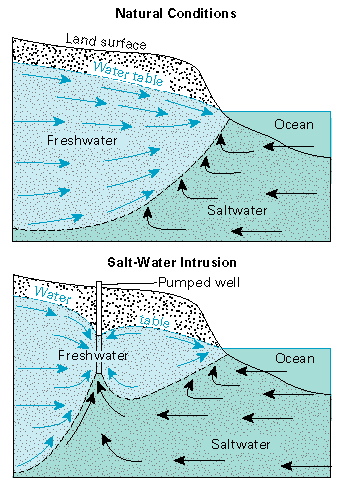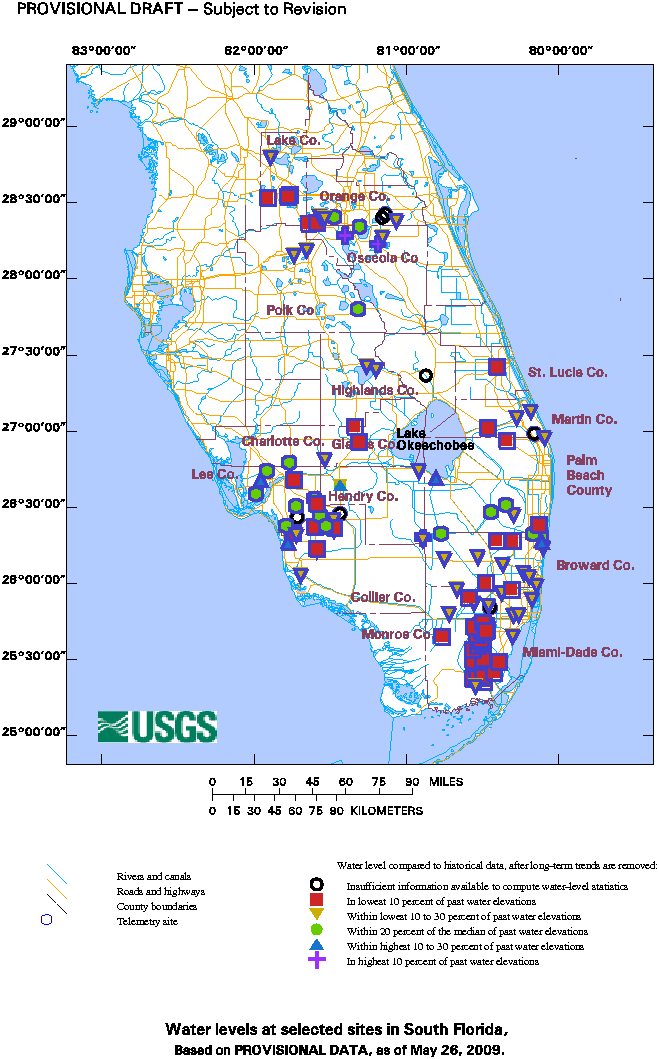By: Barbara McAdam, Urban Horticulture Program Specialist
After 12 years of holding rain barrel workshops and teaching water conservation, I still meet folks in South Florida who ask “why do we need to save water?” The answers may not be as obvious as you think, and I can’t help wondering how many more people would practice water conservation if they understood the nuances of water, rain, and climate in South Florida. A review of some basics is below.
Where does our water come from?

When I ask this question in a Rain Barrel/Water Conservation Workshop I get an array of answers: the ocean, Lake Okeechobee, the sewer, the faucet, or rivers. The source of your municipal water depends on your location and the surrounding natural hydrological system. Our water comes from the Biscayne Aquifer and the deeper underground water of the Floridan Aquifer. Note that in Miami Dade County the Floridan Aquifer is mixed with seawater and is considered brackish needing additional treatment before we can use the water.
Knowing where we get our water from leads to more questions. How does the Biscayne Aquifer get its water? Primarily Rainfall! Great! It rains a lot in Miami! It’s always raining, right, why do I need to save water.
Yes, it rains a lot in Miami-Dade County
Our rainy season usually begins the 3rd week of May and runs through October. We receive approximately 70% (40”) of our annual rainfall in this 6-month span. Our total rainfall averages 56” to 62” a year. Our dry season peak can have some monthly averages as low as 2” to 3” of rainfall. Dry/Season wet season differences can make choosing plants for you landscape a challenge. We have lots of information on what plants are the “Right Plants, Right Place” for South Florida contact me for a list of links from UF publications and other great online resources and books bmcadam@ufl.edu.
When it rains it pours
Part of our perception of Miami as “rainy” may stem from high rainfall events. Rainfall on April 15, 2015 (during a dry season month) produced 5″ of rain in our grove. This caused local flooding in many areas of Miami-Dade County. Advancing winter cold fronts in the dry season can also bring several inches of rain per event. 2015 rainfall data shows we experienced lower than average rainfall for the 2014-2015 dry season until the aforementioned rain event of April 15, 2015. Why? There are fewer cold fronts reaching south Florida and many of the “cool” fronts that do arrive are dry.
Where does the rain go?
Statistically 12% of rain that falls in an urban area will find its way to recharge groundwater resources. The “other” 88% will travel across paved/hard surface areas to the nearest storm water drain/and/or drainage canal. Where does this water go in Miami-Dade County? At this time, most stormwater runoff goes out to the ocean.
With 5″ of rain in one day plants should be good for weeks, right?
Well, actually, NO. Water peculates quickly thru our calcareous soil down to the Biscayne Aquifer. You may have heard meteorologists describe a rain event as a “slow soaker, just what we need for our lawns”. Too much water at one time percolates thru the sandy soil whether the water is from rain or irrigation over watering. How long the plants will benefit from rain depends on length of day, temperature and humidity. If you take a look at ; this is deemed sufficient to provide moisture to the root zone of plants. Irrigation Timing may seem complex for homeowners. Contact Laura or Jesus to learn about how to easily set your timing and the Irrigation Retrofit Rate Program. Twice a week irrigation is regulated per South Florida Water Management District in order to maintain water levels in wells connected to the Biscayne Aquifer, regulations can be found on the Miami Dade County Water & Sewer Departments website.
What if the rainy season starts late?

 Depending on weather conditions, an increase in visiting tourists, dry weather prompting agriculture use and home owner use of water for irrigation, it’s possible that we could face a draw down on wells which are normally at their lowest levels at the end of dry season. The dry season of 2009 was the second driest recorded dry season at that time and we risked salt water intrusion into well fields along the south eastern sector of Miami-Dade County. Do you remember the brief restrictions limiting watering your lawn for only once a week roughly south of SW 216th Street? This additional temporary limitation was put in place to prevent well fields from pulling up brackish water from the underlying Floridan Aquifer or along coastal areas, from pulling up salt water from the underlying Biscayne Bay.
Depending on weather conditions, an increase in visiting tourists, dry weather prompting agriculture use and home owner use of water for irrigation, it’s possible that we could face a draw down on wells which are normally at their lowest levels at the end of dry season. The dry season of 2009 was the second driest recorded dry season at that time and we risked salt water intrusion into well fields along the south eastern sector of Miami-Dade County. Do you remember the brief restrictions limiting watering your lawn for only once a week roughly south of SW 216th Street? This additional temporary limitation was put in place to prevent well fields from pulling up brackish water from the underlying Floridan Aquifer or along coastal areas, from pulling up salt water from the underlying Biscayne Bay.
Is Climate Change Happening?
 Change your focus from conflicting discussions regarding Climate Change and look at recent weather patterns in comparison to historical weather data. Or walk outside in Miami in mid-March and you may find we have already reached temperatures in the 90’s. Our weather patterns worldwide are becoming colder, hotter, dryer, and wetter depending on your location and in some areas in the US it is all of the above within a calendar year. Weather is breaking patterns and records while being subject to more extremes. Advances in modeling and forecasting have advanced and we may be able to forecast events further into the future, but we will still need to be prepared.
Change your focus from conflicting discussions regarding Climate Change and look at recent weather patterns in comparison to historical weather data. Or walk outside in Miami in mid-March and you may find we have already reached temperatures in the 90’s. Our weather patterns worldwide are becoming colder, hotter, dryer, and wetter depending on your location and in some areas in the US it is all of the above within a calendar year. Weather is breaking patterns and records while being subject to more extremes. Advances in modeling and forecasting have advanced and we may be able to forecast events further into the future, but we will still need to be prepared.
What about Sea Level Rise?
 Sea Level Rise is well documented and flooding events in our beach and bay communities are on the rise. The “super moon” events of 2016 brought record high tides to South Florida. Increases in high tide levels have reportedly increased by 400% in the past 10 years. Well fields are being inundated by salt water intrusion due to Sea Level Rise and are being taken out of service. The inland line of salt water intrusion into well fields is closely monitored by Miami-Dade Water & Sewer Department through data provided by USGS and South Florida Water Management District. Our Urban Conservation Unit is also finding more instances of salt water intrusion attributed to sea level rise as they conduct site visits for the Irrigation Retrofit Rebate Program.
Sea Level Rise is well documented and flooding events in our beach and bay communities are on the rise. The “super moon” events of 2016 brought record high tides to South Florida. Increases in high tide levels have reportedly increased by 400% in the past 10 years. Well fields are being inundated by salt water intrusion due to Sea Level Rise and are being taken out of service. The inland line of salt water intrusion into well fields is closely monitored by Miami-Dade Water & Sewer Department through data provided by USGS and South Florida Water Management District. Our Urban Conservation Unit is also finding more instances of salt water intrusion attributed to sea level rise as they conduct site visits for the Irrigation Retrofit Rebate Program.
What other issues stress our water resource?
Population! More people = more water. Locally Miami-Dade County’s population is estimated to be 2.7 million people. Miami-Dade, Broward and Palm Beach County population estimates have reached 6 million people, we all use the Biscayne Aquifer as our main source of drinking water.
Don’t blame the farmers
Right after the need for water to survive comes food. The length of time we could survive without water would depend on temperature and exertion. Survival without water can only be mere hours if you become dehydrated on a hot day while working hard. If you are consuming food that contains water (fresh fruits & vegetables) and you are comfortable, you might survive for weeks. Without food and in healthy condition you may survive up to eight weeks, but it wouldn’t be pleasant. Most of us would be ravenous after a few days. Water is needed to grow the foods we consume. You can grow some crops with little water, but it would be difficult to provide enough food to sustain the population of Miami-Dade County. Worldwide, Food Security is considered one of the most serious challenges we face.
Will we run out of drinking water?
No, but the cost of water could definitely rise if reverse osmosis or other advancing technologies are needed to remove salt from brackish or seawater instructions into the Biscayne Aquifer. We are extremely fortunate to have a clean, relatively steady source of drinking water, the Biscayne Aquifer is one of the finest fresh water resources on our planet. With due diligence, learning and practicing the many simple ways to save our water, it will be here for future generations, for our children and for all of life that needs water to live in our South Florida environment.
Learn more!
Link to our Eventbrite page to see and register for upcoming workshops & presentations on Rain Barrels, Water Conservation, Right Plant, Right Place, Planting for Pollinators, Imperiled Butterflies of So. Florida.
Additional Resources
- Florida’s aquifer adventure – Florida Geological Survey Video
- Water, Water, Everywhere: Sea Level Rise in Miami
- Climate Change Resource Center/ Climate Basics
- NASA Global Climate Modeling
- Climate Impacts on Water Resources
- Miami-Dade Sea Level Rise Task Force Report and Recommendations
- USGS Coastal Groundwater Systems
- The Effect of a One-Foot Sea Level Rise on Saltwater Intrusion in the Biscayne Aquifer in Miami-Dade County, Florid
- Ground Water Atlas of the United States: Alabama, Florida, Georgia and South Carolina
- U.S. Census Bureau Quick Facts for Miami-Dade County, Florida
- US Climate Data – Miami
- Watering your Florida Lawn
- Miami-Dade County Water & Sewer Department Conservation Program
- Whacky Weather, What Up With That?
- UN Sustainable Development WATER
 0
0
